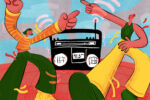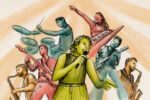Beatboxing and speech therapy. Yeah, they’re not the most conventional activities to pair together, but the masterminds at BEAT Global don’t see the oddity. With their program BEAT Rockers, kids with disabilities learn the foundations of beatboxing to help them learn how to pronounce certain sounds and make music with the only instrument they need: their voice.
Bridging Education & Art Together, also known as BEAT, is a nonprofit organization in New York City. Established in 2009, BEAT Global uses world-class artists to teach young students the foundations behind different art forms. These art forms range anywhere from breakdancing to songwriting.
According to the official website, “[Our] mission is to transform the lives of youth by empowering artists to build community through creative self-expression rooted in advancing Hip Hop culture.”
BEAT Global provides therapeutic and creative lessons for those who suffer from depression, violence, obesity and communication disorders. Their ultimate goal is to maximize students’ retention and engagement in a fun and safe environment. Backed by technology and research, BEAT Global’s programs develop strategies for retention and engagement to combat the limitations their students face on a daily basis.
One of the programs that continue to make an impact in children’s lives is BEAT Rockers. By teaching the fundamentals of beatboxing, BEAT Rockers serves as a music program at the Lavelle School for the Blind in the Bronx.
I spoke with BEAT Global’s Executive Director, James Kim, to learn more about his innovative, fun and educational program.
Back in 2009, the Lavelle School for the Blind invited Kim to DJ at one of their dances and what Kim saw that night was something that he’d never forget.
“It was a super powerful moment,” Kim said. “I was incredibly moved by the way the kids were reacting to music. I had never experienced that before. Think about, like, a gym full of kids at a school dance, and they’re all in their dresses and little suits. The music is bumping, and these kids are just freaking out in the best way possible.”
After witnessing such a pure moment, Kim thought about organizing a beatboxing showcase for the kids. He wanted to show the students that people can create the music they heard blasting through the speakers just by using their mouths. It’s what Kim called “an audio magic trick.”
After reaching out to Taylor McFerrin, a renowned musician and beatboxer, and speaking to the principal of the Lavelle School for the Blind about the possibility of starting a program for students, the BEAT Rockers initiative was born.
In its 10th year, Kim said he and his team never intended for BEAT Rockers to become a tool for speech therapy, but Lavelle requires its students to attend a speech therapy session once a week. After the first semester of BEAT Rockers, the school’s on-staff speech language pathologists started noticing a change in their students.
“They were just like, ‘I don’t know what you guys are doing in the program, but the kids are just much more vocally expressive. They’re beatboxing in the hallways and they’ve sort of opened up,’” Kim said.
It was an intriguing concept for BEAT Global to consider. If students with speech impediments could learn how to beatbox, then maybe they could learn how to properly articulate the sounds they struggle with the most in everyday speech.
“Where beatboxing can really make improvements is in repetition and muscle memory,” Kim said. “Those are the two things you need to get better at certain sounds that, let’s say, you’re having trouble articulating.”
Kim said that beatboxing is a way for the kids to actually want to practice what they’ve learned. They don’t always have to recite countless flashcards. They can start laying down beats anytime, anywhere.
“What is language but a bunch of weird noises that we make?” Kim asked. “We just choose to give those noises meaning. Beatboxing is the same thing. It can articulate just as much meaning, but you’re using music as opposed to words.”
Kim also mentioned that BEAT Rockers teaches students about common social cues when they’re having a conversation. Beatboxing with a group of people allows the students to learn how to take turns by recognizing when to come into the beat and when to go out. The students also learn how to make eye contact.
Even after all of the program’s success, Kim wants to make it clear that beatboxing is not speech therapy, and it’s not a cure for speech impediments. However, he still believes that it should be implemented in every music program geared toward people with disabilities.
“[Beatboxing and speech therapy] just hasn’t been explored enough,” Kim said. “I think the qualities that make beatboxing so unique is the fact that kids can start doing it immediately. If you’re a kid with a disability, you don’t have to make any modifications or any adjustments. You can just start doing it.”
Kim sees the speech therapy side of BEAT Rockers as a smaller manifestation of the bigger picture. For him, it’s all about showing the students that despite any disability, they can still be part of the creative process of music.
“I look at beatboxing like a key,” Kim said. “It just unlocks all this existing creativity that’s already in a kid; you just need a way to get it out. That’s really what we’re trying to do as an organization.”
As BEAT Rockers continues to bring the Lavelle students the key to unlocking a treasure buried deep within themselves, the students learn that their newfound ability to create music is limitless.
“The kids are making music with their own bodies. It really flips the script in terms of the kids looking at themselves as these very powerful creators. You’re really celebrating what the kids can do.”
















